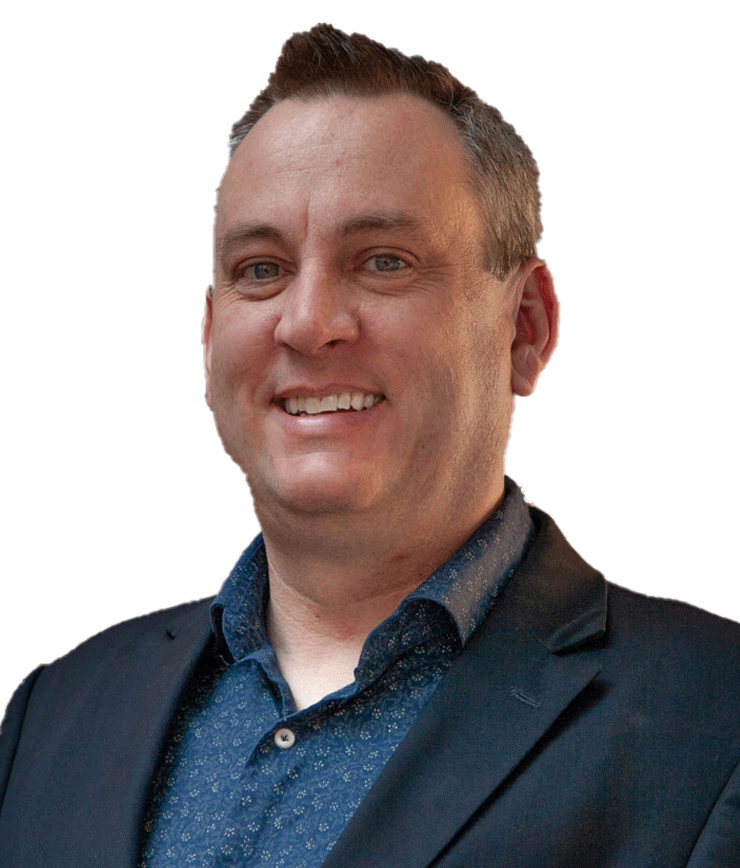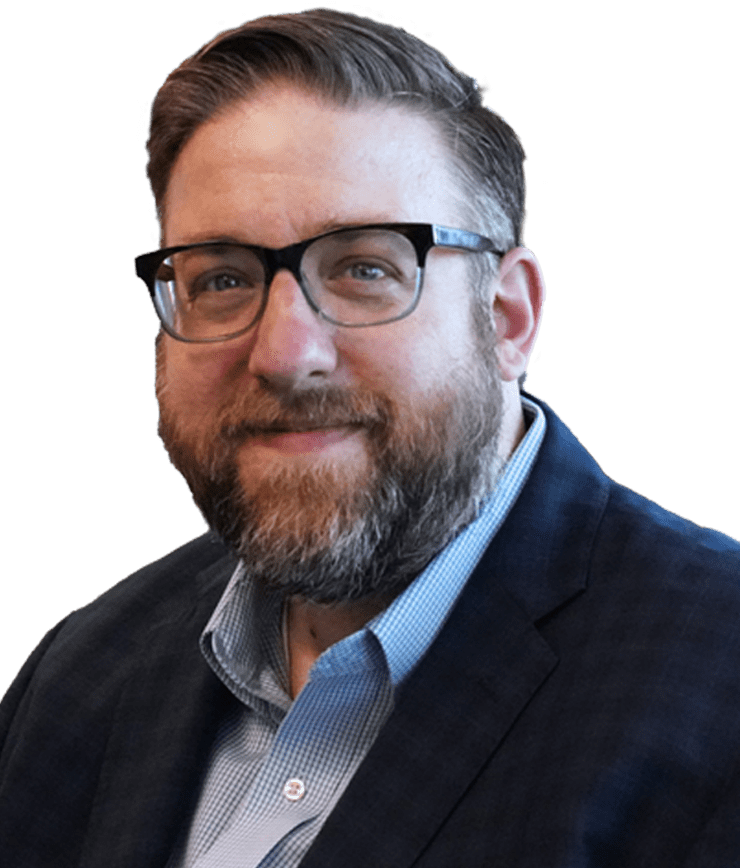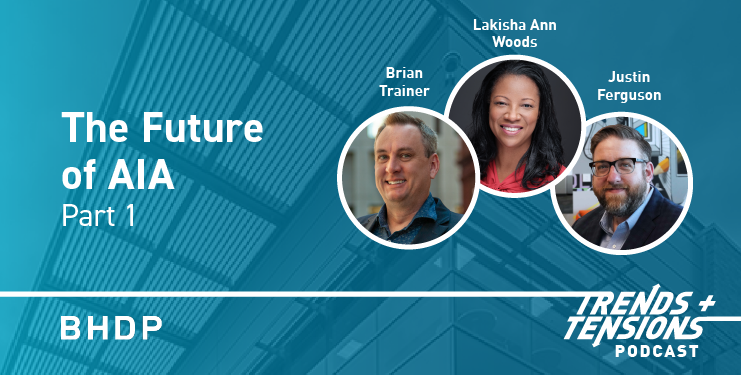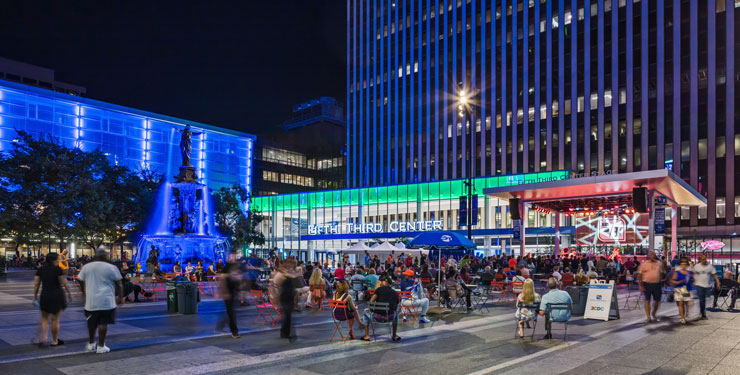
The Future of AIA: Part 2
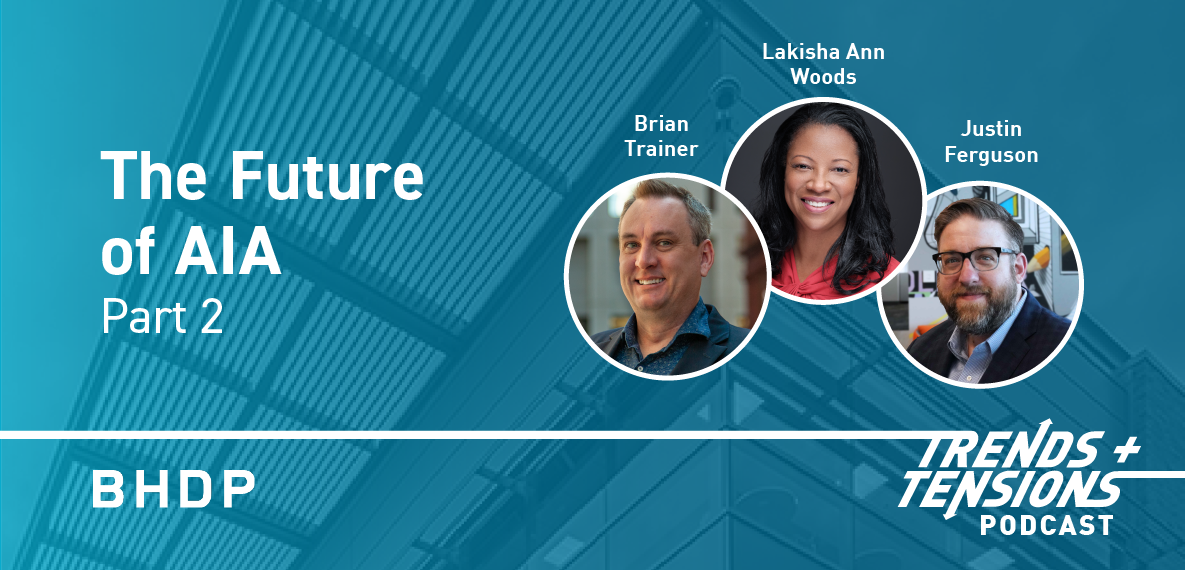
Want to listen on another platform? Choose your platform here.
Episode Transcript
(Music Intro)
Brian Trainer, Host: Welcome to Trends + Tensions presented by BHDP, where we discuss trends in architectural and interior design and the competing priorities or tensions that arise from integrating new ideas into existing organizations, enterprises, and institutions. This episode, “The Future of AIA: Part Two,” we finish our conversation with Lakisha Woods, Executive Vice President and CEO of the American Institute for Architects, and my guest co-host, Dr. Justin Ferguson, a lead strategist at BHDP and an active member of AIA. Lakisha, who began her tenure as EVP and CEO at the beginning of 2022, has been busy laying the groundwork for AIA’s future, which involves a more equitable, diverse profession and more sustainable built environment. We connect with her, fresh off her appearance on the first season of the CBS show, America ByDesign: Architecture. I'm your host, Brian Trainer, senior strategist for BHDP, and this is part one of a two-part series.
Justin Ferguson: We've talked about EDI in leadership. So EDI, DEI—we’re talking about equity, diversity, and inclusion. Sometimes we have JEDI, which is justice added into that. What we've talked about here in leadership, we're seeing it there at AIA National. But what about the pipeline for future professionals? So, some firms have responded by saying that they can't find diverse talent, and others are at the other extreme, having said they'll just go higher from historically black colleges and universities, right, or HBCUs. So, setting aside that argument, which you brought up, right, that they give is that we can't find diverse talent. And that could be from a limited demographic profile. How can firms appropriately approach and engage universities, especially HBCUs, to reach out to students of color to generally develop relationships and attract talent?
Lakisha Ann Woods: That is a really common question, by the way, and not just for this specific profession of this industry, but associations as well. I need to show my board that I am reaching out to find diverse talent, so I'm going to go have a meeting at an HBCU. Well, the first thing I will always share with someone who's going to go in with their leadership team to recruit from a historically black college or university or recruiting diverse people is who's walking into the room with you? Is there anybody diverse on your team to show those young students that they have a place in your firm? Any student today will have already researched your firm online before your conversation is over, and if they don't see anybody diverse on your leadership team, then in their mind, there is no place for them. If you don't have a Chief Diversity Officer, someone whose job is to focus on, especially depending on the size of your firm, but if you're a medium-sized to a large firm and you have no one focused on ensuring that there are equitable practices happening within your firm, training education—that is an ongoing process because trust me when I say everyone needs training on diversity and inclusion—me, you, and everybody needs ongoing training because we're humans and human nature is to fall back on your biases. Everyone has biases, and they often influence the decisions that we make in the workplace, and they often will negatively influence decisions when you leave someone out that may have the best idea because of your own bias, whether it's age, gender, or race. So many things go into play that people don't even realize, and often because people recruit from the groups that they know, from people that they’re familiar with. So when you step into a room with people that are different than you, you often don't know what to say, or you feel a little uncomfortable, so I also tell people that we have to be comfortable being uncomfortable. I'm a military brat, so I grew up everywhere, and I was often the only person that looked like me in the room, so I'm really comfortable being in a space where I don't look like anybody else. I think I'm more uncomfortable at my own family reunion. It's just important for us to step outside our comfort zone and to recognize that it's important to have people that don't think the same way because that's what will create a better design, a more innovative design, a better plan for your business overall. So I just always remind people to take a look at who you're bringing to the table if you're trying to recruit someone because if you're telling them that they're welcome, but they don't see anyone that looks like them, then they don't think they're welcome.
Brian: Yeah. That's a fascinating way to approach it because it's like, “yeah, you're welcome here!” Really? Is there somebody else like that? And I think there's a component of that, too, though, that if you do have someone that looks like that, you don't just say, “Hey, come here; we need you to represent this.” You have to have a conversation with that person about, “hey, we're not going to use you as the standard bearer just because you look like the other people. Is it okay with you? Is this something you want to champion?” I mean, that's important as well, right, that we're not just creating tokenism? Is that a fair way to express that?
Lakisha: That's why it's so important to not just have the lone minority, because that's the other data point, right? They say that if you have a board room and you bring one woman into the room, then that one woman's voice does not have the power that it would need. You need to have at least 20% of a specific group for their voice to be valued at the table. So it can't be the lone ranger. And I know because I fought that battle, and it's just it's lonely, and it's tough. But it's fine because we're going to get to where we need to be. I know that. We have to. It’s adapt or die, right? And that's what we have to do, and that's why we get out here and we have the conversations, and we continue to train and provide tools and resources. That's why we're here and I really love every minute of it.
Brian: Escaping your bias—it’s amazing how that finds Its way in everyday life because I'm working with a theater department, and we're building a set, and we had a bunch of volunteers show up to help, and I had a retired civil engineer, myself with the background in architecture, and then one of the actors brought their 18-year-old son, who's studying electromechanical engineering, and I'm like, “Electrical mechanical engineering is not real engineering.” That was my first thought that hit me. Then we had this structural problem of framing up these walls so they wouldn't wobble when the actors closed the doors. The 18-year-old solved the problem. I was just like, “Here's the problem. See what you can do,” He was working with the structural engineer, but it was his idea. Had I said, “No, you can't do this. Go do something else,” I would have missed a really great opportunity, and it would have still been my problem to solve. So I had the bias, but then I was like, “Alright, go ahead.”
Lakisha: That is a wonderful example. You should share that often because what I'll also hear people say is, “Oh, yes, we need to have more diverse people as a part of our team and more leaders and more young people. You know that kid? They had a really good idea.” Well, let's start by not calling them “kids.” They're standing in front of you. They don't want to be referred to as “kids.” They have a college degree; they spent all this time studying architecture. Respect them and recognize that they may have some great innovative ideas that you wouldn't even think of because of how they were trained today. So how do we step out of our own skin, out of just the terms we use, to make people feel welcome?
Justin: It's the diversity of experience. For a lot of people, it's only about color, or it's only about gender. No, it's about bringing to the table people with different experiences and making sure they have a voice because so many times we hear, especially within our firms, “Oh, we didn't hire so and so because they weren't a cultural fit. Maybe it's time that we hire people that aren't a cultural fit, that don't look like us, don't act like us, don't have the same experience so that they bring something new to the table for us.
Lakisha: Because if everybody is the same and has the same culture, and when we say culture, it's meant in a different way, it's not going to help your organization grow. At the end of the day, that's what it's about. I always say that I'm very much an extrovert but fascinated by the introverts, and I want to learn from them. I sort of sit and think, “Come on, say something. Teach me. I want to listen. I want to learn from you,” because we just need to be around people that are different than us because they have so much to share. And different styles—it’s everything. Again, diversity of thought, diversity of all the variations. But it's important for us to constantly be intentional about bringing people into the room and making them feel welcome and listening to their voice, and valuing what they have to say. So we will continue to develop the tools that you need to make that happen.
Justin: Alright, so I'm going to take us back, pretty much back to your beginning here at AIA. So at the 2022 AIA Conference in Architecture, you challenged attendees to consider how they will use their talent and expertise to continue to advance a future that is more equitable, inclusive, and sustainable. Did you happen to hear any unique or exciting responses to your challenge? Did anybody rise to that?
Lakisha: Boy, that's a tricky question. I've heard thousands of stories over this past year, so I can't think of one that came to mind in particular, but what I will say is that, especially at the conference, in which that experience in and of itself was so overwhelming, in a way. The emotion that people brought—years of hope or aspirations, young people and different people who've been involved in different ways throughout the years at the local level, state level, at national, and they all had a story to tell, and they shared, and they were very vulnerable—it meant a lot that people felt so open to talk to me when I'm fairly new. So I've tried to listen and retain those stories to look for crossover in where I hear some repetitive issues or opportunities for us to be more successful or more supportive of those in our profession, a lot of topics around mental health, and finding balance and how we can support those needs that they're having. Also, again, I've always wanted to know that there are more people that look like me that are in this profession. One of the things that the program that you're referencing, that we started the beginning of this year, and so each Friday we are going to feature a woman, a man, a person within our profession, that is either celebrating their success or how they are intentionally bringing diverse leaders forward within our profession. So, to me, that's what people were telling me. We need young people to see more people that look like me, that shared their struggle, that shared their success. People need to see not just the fact that there are more women and minorities that are in this space but also to celebrate their work because oftentimes, if you see a story about an architect, it is, “Oh, this is this female architect, and this is who she is, and this is the challenges she's faced,” but you don't see her work. I said, “Let's celebrate the work. People want to see the great designs that have come from these talented professionals, and so that's what we're going to do. We're going to spend each week, every Friday, and look for the next iteration of how we're celebrating the great work of women and minorities in this space and those that are doing their part to elevate them. And I think that is important and especially because of the Google machine, as I like to refer to it—whenever I Google the top 100 architects or things like that, those generic statements, I’m not getting women in the mix, let alone a minority. So we have work to do so that people know that the top architects can look like anything,g and they can be a part of it, too. And that's how we're going to be able to recruit more young people into this profession. We have to convince them that it's worth the hard work to be an architect, and we need them to know that it's worth all the blood, sweat, and tears to get here and be able to make the difference that you do in society because I know architects are changing the world and I just want to make sure that we can recruit more passionate professionals to be a part of the space.
Justin: Well, that's great. I think we really look forward to seeing, again, that storytelling happens. So let's imagine we did it—I’m going to throw us into it as well with you and everybody—and we push the profession and its members to focus on equitable, inclusive, and sustainable practices. That question being: what does success look like?
Lakisha: Oh, a perfect world where everyone feels that they have a space and a place that they are part of this profession, that they have an opportunity to lead no matter what they look like. I believe that to me, one of the big wins would be not only that we have a broad , diverse spectrum of architects within our profession, but they are also paid a solid wage for the work that they do—elevating the value of that work and making it priceless because that, to me, is another area that we must focus on—no more free work. Being able to have people pay you for all of the great work you do and really increasing that price point that people are willing to pay for the great architectural design work for all of the now very inclusive, diverse group of architects that are a part of our profession, in a perfect world.
Brian: That's interesting. We’ve studied workplace architecture a lot within corporate environments, and the workplace itself was originally designed to satisfy the male workday because the man was the provider for the family that left. Are there any success stories of people who are doing a better job supporting professionals that are considered caregivers? Because I was a single dad for a long time, so I kind of experienced the pain of not advancing in my career as quickly because kids got sick and I was missing days, and it just looked like it wasn't there. And I know that mothers suffer that more than anyone. Have you seen anybody creating successful programs to help women be elevated at the same rate as men, regardless of whether or not they're caregivers? Because that's still a traditional gender role that we haven't completely overcome.
Lakisha: In the perfect world, any gender is responsible for caregiving, and it doesn’t lean on one versus the other, and there is an equitable balance of roles in the family in addition to the workplace, says the mother of a four-year-old. Again, it is so important. What I really found interesting is I had the opportunity to be a part of the LFRT, the Large Firm Roundtable. The large architecture firms have a group of HR professionals that work for those firms, and they come together and share ideas about what programs they are creating in order to have better wellness and environments. They really are trying to create programs that will manage for everyone to be able to better manage their work-life balance. And so they're trying. It’s tough when you're a small firm, right? Any entrepreneur, if you're a small business, no matter what business you're in, you're wearing all the hats, and that may be more difficult, but at least if at the large firms they can create those programs that offer a work-life balance that offer the flexible hours—I know people who work at firms who've got really great balance within their life, and that's why they stay at that firm it's just a matter of getting great examples that we can share with medium-sized firms or smaller firms that can find that balance and still get the work done. Either way, companies lose out if they lose mothers, so they have to find that balance, or you are losing innovation and dollars down the drain. So find a way to make it work. Don't lose the workforce that's going to create the success for your future.
Brian: Thank you for answering that. I love that answer.
Justin: Thank you so much. I really appreciate this. It is an honor to get this time with you and get to talk about these issues. Thank you so much.
Lakisha: Thank you for the time. Thank you for inviting me to be a part of this podcast, and again, if anybody has any questions, aia.org is our website, which has a lot of information and is also in the middle of being redesigned based on feedback from our members, so look for the aia.org next gen coming out in the coming year. Again, we're here to serve our members’ needs and hope to see you all in San Francisco at AIA’s conference, June 7th through the 10th, and the Women's Leadership Summit in Boston, September 14th through the 16th.
Brian: Perfect. Thank you very much for that, and thank you for joining us today. Thank you for joining Trends + Tensions presented by BHDP for this episode, “The Future of AIA: Part Two,” with Lakisha Woods of AIA, and my guest co-host, Dr. Justin Ferguson. If you appreciate what you've heard, please rate, subscribe, and give us a review. I'm Brian Trainer, your host, and I hope you'll join us for another episode of Trends + Tensions to see what topics drive design.
Author

